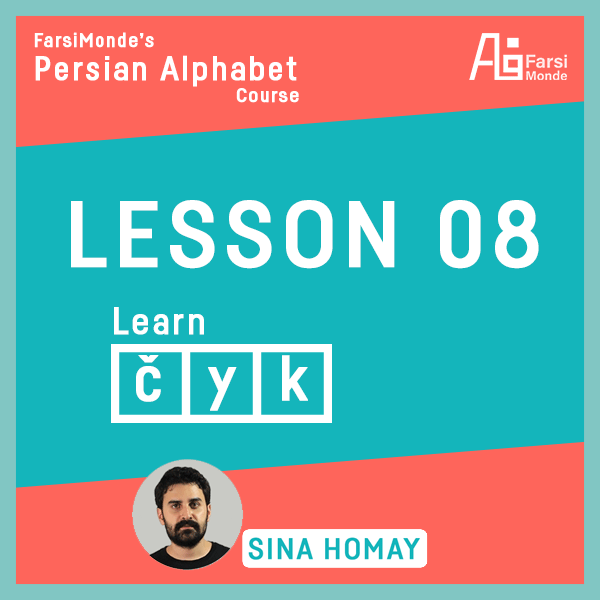Learning Persian Alphabet (08)

Welcome to the eighth episode of the Persian Learning Alphabet Series. In this lesson, you will learn how to write “č,” “y” and “k.” The “y” sound is the most complicated one among these three. Are you wondering why? You’d better read the caption before watching this episode.
“č” in Farsi
Your first question might be what sound this “č” is. As we mentioned before we use simplified IPA symbols in FarsiMonde for some letters that do not have a one-letter equivalent in the Latin alphabet. “č” is a sound that exists in English, too but is shown by “ch.” Therefore, if you can pronounce English words like “chair” you won’t have any problem with this sound.
If you have already learned the Arabic alphabet, add this letter to your alphabet list. The Farsi Alphabet slightly differs from the Arabic one. Four letters in Farsi do not exist in Arabic. You are learning the second one in this video. The first one was “p” in the third video.
“y” in Farsi
The “y” and “i” have almost similar written forms. If you had forgotten how to write “i” you can watch lesson four again. The difference between these two letters is in the beginning. As you may remember, all vowels, including “i” start with the vowel sing which is “ا”. So “i” in the beginning is written as
ایـ
Now remove the vowel sign and the remaining will be “y” in the beginning. The two sounds have the same written forms in the middle and at the end.
Sometimes, “y” and “i” come one after the other in a word. “piyâz (onion)” and “pâyiz (autumn)” are very good examples. In the former, “i” comes before “y”. In this case, we write only one “ﻴ” so the word is written as “پیاز.” But in the latter, the “y” sound comes before “i”; therefore, we write both “y” and “i.” So it is written as “پاییز.” Please don’t ask why. It is a rule. Learn it as it is.
i+y → یـ
y+i → ییـ
Sentences to Practice
Are you ready to expand your Farsi with new verbs? By learning “k” you can write the most frequent Farsi verb, “mikonam,” which means “I do.” Remember that the verb is never used alone. But you can make lots of phrasal verbs with it. Why not try to write the following short sentences? You will also learn verb conjugation in Farsi by writing them. Can you make more sentences by what you have learned so far? Please leave comments and write them for us.
- man šenâ mikonam. = I swim.
- to čat mikoni. = You are chatting.
- un âšpazi mikone(h). = S/he cooks.
- mâ ârâyeš mikonim. = we do make up
- šomâ keyk dorost mikonid. = You make (bake) cake
- unâ be man komak mikonand. = They help me.
FarsiMonde’s tutors attempt to make learning the Persian Alphabet simple and enjoyable; therefore, we designed writing exercises you can work on at the end of each video. Click on below to start the new lesson’s quiz.


Leave A Comment